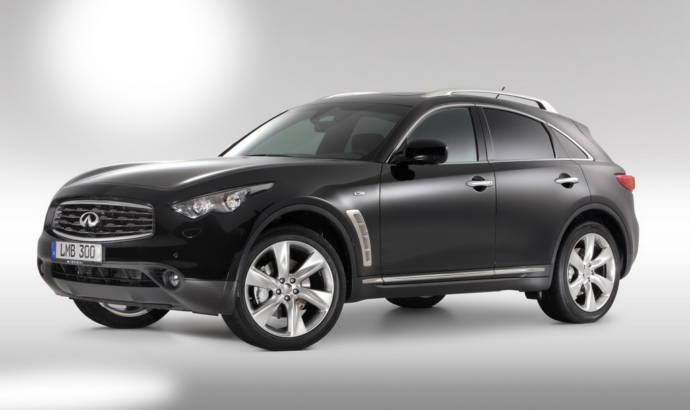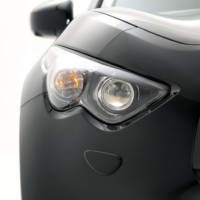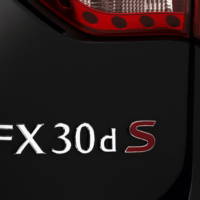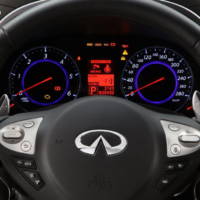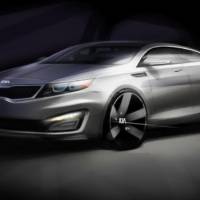Infiniti is introducing its first diesel model, the FX30d that features the new direct fuel injected 3.0-litre V6 under the hood.
Besides the Infiniti FX30d this engine will also be fitted on the EX30d and M30d models so besides performance customers will also enjoy a high level of efficiency.
The Infiniti FX30d produces 238 PS (175 kW) and 550 Nm of torque and its standard 7-speed automatic gearbox enables the luxury SUV to accelerate from 0 to 100 Km/h in 8.3 seconds.
Covering 100 Km means the Infiniti FX30 will need 9.0-litres of fuel while emissions are 240
g per Km, place the new SUV under the EU5 emission standards.
The Infiniti FX30d price was not annunced yet.
Infiniti press release :
ROLLE, Switzerland (February 19, 2010) – Phase two
of Infiniti’s quiet assault on the European luxury car market is
underway with the arrival of a newly developed 3.0-litre V6 diesel. The
engine, the first in the brand’s 20 year history, has been specifically
designed to deliver high levels of refined performance in line with
Infiniti philosophy. It will initially be available in both the
acclaimed EX and FX crossovers and later in the Infiniti M luxury
performance sedan.
The new diesel is a key element to Infiniti’s continued growth in
Europe. Launched barely a year ago, the Infiniti range has won high
praise from customers and the motoring press alike. Now with five
established model lines – G37 saloon, coupé and convertible, plus the
EX and FX ranges – more than 2000 Infinitis have been sold across 15
markets despite the marque’s launch coinciding with the worst global
recession for decades.
A sixth model, the Infiniti M Line, will be launched during 2010 and
it, too, will be available with the choice of petrol and the new 3.0d
unit.
“The sales success enjoyed by Infiniti in Europe against a backdrop
of financial uncertainty proves the cars’ appeal to a discerning
audience. We have established Infiniti as the luxury
performance brand thanks in part to the remarkable multi-award winning
VQ petrol engine that powers most of the models in the range,” said Jim
Wright, Vice President, Infiniti Europe.
“We were aware from the outset, however, that for Infiniti to offer
a complete range a powerful diesel engine was a must, especially in the
European premium SUV market where diesel represents the bulk of sector
sales.
“Although we did investigate the possibility of adapting an existing
large capacity diesel for Infiniti, we quickly established that nothing
on the market met our exacting requirements. We needed an engine that
delivered not just stunning performance but exemplary refinement too.
For that reason, with the Alliance we decided to develop our own
engine, a performance diesel worthy of the Infiniti badge,” said Wright.
The performance figures speak for themselves. Developing 175 kW (238
PS) and a remarkable 550 Nm of torque, with standard seven-speed
automatic transmission the new engine sends the EX30d to 100 km/h from
rest in 7.9 secs and the FX30d in 8.3 secs. However with all that
torque, it is in their overtaking performance that the Infiniti’s
advantage will be most felt. (All figures subject to final
homologation.)
The V6 diesel in detail
Designated V9X, Infiniti’s new V6 diesel has been developed in Europe
by Infiniti engineers working with other engineers from Renault and
Nissan. It is made at a state-of-the-art facility in Cleon in France,
some 100 kms west of Paris. From the very start of development, the new
unit was created to answer Infiniti’s demands for a powerful but
exceptionally refined diesel engine, quiet enough in use to match the
high standards set by the petrol engine.
The unit will also be used in cars from Renault and Nissan, allowing
both those brands to broaden the appeal of specific model ranges at the
same time as boosting production volumes of the engine. Unusually, V9X
will power front-wheel drive, rear-wheel drive and four-wheel drive
models.
With Infiniti’s specific requirement for a compact unit delivering
high levels of power and torque with competitive emissions, strong
economy and unrivalled refinement leading the development, work on the
direct injection 2993cc V6 began in 2005.
Although a V8 diesel engine was investigated, the V6 format was
identified early on as the ideal layout for the unit, providing the
optimum balance between overall performance, refinement and volume
potential across the three Alliance brands. Target performance was 238
PS (175 kW), 500 Nm of torque and early compliance with forthcoming
Euro 5 emission legislation.
At the same time, the engine bay architecture of the EX and FX
models – designed initially as petrol models only – called for a
compact engine which, if it were to be used in both transverse and
longitudinal positions, would need to have a comparatively narrow vee
angle as close to 60 degrees as possible.
Engineers decided that the ideal vee angle for the unit would be an
unusual 65 degrees. This offered an excellent compromise between
crankshaft balancing, crankshaft and cylinder block reliability and
engine packaging with the 65 degree angle wide enough to allow the
single turbocharger to be neatly mounted within the vee.
But perhaps the key element to the success of the new V6 is the
material chosen for the engine block. While some rivals tend towards
aluminium-alloy cylinder blocks to reduce the weight of their diesel
engines, development engineers felt that to achieve the desired levels
of refinement an aluminium block would need extra material added to
increase its stiffness and reduce noise levels. It might also need
extra complexity added in the form of balancer shafts to boost
refinement, but all these additions negate the weight advantages of an
alloy block.
Conventional cast iron, however, would place too much weight over
the front wheels and lower the levels of driving pleasure offered by
all Infiniti vehicles. In its place, the engineers chose Compacted
Graphite Iron (CGI), a material that offers all the benefits of cast
iron and more – it has higher levels of stiffness and noise absorption
– but without the weight penalty. And while CGI is heavier than a pure
aluminium block there is no need to add stiffening ribs or extra sound
deadening material so the weight gain is comparatively modest.
CGI was patented in 1949 and its first commercial application was
for the brakes of Europe’s high-speed trains. It is 75 per cent
stronger and up to 75 per cent stiffer than grey iron, the most common
form of cast iron found in engine cylinder blocks. It also performs
better than aluminium at higher temperatures when it is up to five
times more fatigue resistant. Best of all, the weight of a typical
engine block can be more than 20 per cent lower than an equivalent cast
iron block.
To manage the high loads on the engine structure commensurate with
the impressive power and torque outputs, the overall stiffness of the
engine structure was optimised at the design stage by incorporating a
number of specific features. These included a large and stiff coupling
face between the converter housing and the engine; the CGI cylinder
block with semi-deep skirts; direct bolting of ancillaries on the
crankcase; an integrated engine bracket in the upper timing covers; a
structural oil pan; a stiff torque converter housing and an axial
driveline bearing on the gearbox side.
At the same time, to reduce vibrations inherent in a diesel engine
and avoid unwanted resonances in the rev range, intensive structural
optimisation during the preliminary design stage used finite element
calculation to identify both the source of vibrations and to establish
the ideal structural form of the block.
The result is a compact, architecturally stiff and refined unit that
by itself delivers two of Infiniti’s design goals: high levels of
refinement and no loss of chassis balance. In tests, Alliance engineers
have determined that the V9X engine has the lowest 250 Hz and 500 Hz
vibrations of all the benchmarked engines.
The main dimensions of the unit are:
| Cylinder arrangement | V, six cylinders |
| Displacement | 2993cc |
| Bore x stroke | 84 x 90 mm |
| Bore pitch | 92 mm |
| Vee angle | 65 degrees |
To ensure it fitted under the bonnet of both the EX and FX models,
there are a number of significant differences between the Infiniti
engine and its ancillaries and the version used in front-wheel drive
applications. A number of changes also had to be made to the engine
bays of the EX and FX.
As used in Infiniti models, the engine has a different cylinder
block, a new design of crankshaft as well as new or revised intake
manifold, fuel injection system, exhaust gas recirculation,
turbocharger, oil sump and manifold catalyst. It is tuned differently,
too, for more responsive performance and is ‘dressed’ differently, in
keeping with the visual identity and design expression of the Infiniti
brand.
Differences between petrol and diesel versions of the EX and FX
models are equally far reaching and include a new front subframe,
different front bumper designs to enhance air flow into the engine bay
as well as redesigned sheet metal within the engine bay to house
additional radiators needed for cooling.
The next phase of the engine’s development was to achieve the high
levels of performance demanded by Infiniti owners. The result is a
clean sheet design that takes current direct injection technology to a
new level. Combustion chamber design has been optimised to improve the
balance between emission levels and fuel efficiency and the compression
ratio has been lowered to 16:1 to benefit not just economy and
emissions but also noise, vibration and harshness (NVH).
The depth of the cone-shaped valve pockets have been reduced and a
mini-sac seven-hole injector nozzle adopted while the bowl diameter has
been widened and the spray angle adapted accordingly for a better swirl
effect at the same time as reducing thermal losses. Internal engine
friction is reduced by the use of ultra smooth components such as the
micro-finished forged steel used for the crankshaft.
Class leading levels of torque and highly competitive specific power
outputs are delivered thanks to the adoption of a comparatively large
single turbocharger, which is mounted within the vee of the engine, an
intercooler and the use of the latest generation of Bosch common-rail
fuel injection. This system incorporates piezo injectors and operates
at 1800 bar.
Power output is bang on target at 175 kW (238 PS) while the
class-leading torque output of 550 Nm (for rear and four-wheel drive
applications) is better than the target. Better still, peak torque is
achieved from as low as 1,750 rpm and is available all the way to 2,500
rpm, while as much as 500 Nm is available from a mere 1,500 rpm. Idle
speed is an exceptionally low 650 rpm with none of the NVH usually
associated with a diesel.
The result is strong low-end performance with comfortably refined
delivery. Throttle response is exemplary and although noise is kept to
a minimum, special tuning of the exhaust note provides a pleasantly
sporting note at about 2,500 rpm under hard acceleration.
Engine refinement is complemented by Infiniti’s smooth seven-speed
automatic transmission, standard on both EX and FX, which has been
tuned to take full advantage of the high levels of torque.
“Whether at idle or at 2,000rpm such is the refinement of the new
diesel engine that the only way a driver will know what’s under the
bonnet is by looking at the rev counter and seeing where the red line
falls,” said Wright.
Performance and construction
| Power | 238 PS/ 175 kW |
| Torque | 550 Nm from 1,750-2,500 rpm |
| Intake system | VN turbocharger and intercooler |
| Injection system | Common rail, 1800 bar and piezo injectors |
| Compression ratio | 16:1 |
| Camshaft drive | DOHC, chain and pinion with mechanical lash adjuster |
| Valve drive | Roller finger follower and hydraulic lash adjuster |
| Valves per cylinder | 4 |
| Cylinder head/block | Aluminium/CGI |
With performance meeting or exceeding the design goals, the final
stage of engine development was to ensure the V6 met or exceeded
emissions and fuel efficiency targets, including achieving Euro 5
compliance. In addition to the advances made by the changes to the
combustion chamber, the V9X engine also incorporates a number of
innovative features designed both to enhance emissions performance and
improve reliability.
Among these is the adoption of an overcooled Exhaust Gas
Recirculation (EGR) system which reduces NOx emissions. The system
incorporates an integrated exhaust gas by-pass in the EGR cooler which
quickly helps to achieve the optimum temperature after start up so that
the full cooling capacity can be used. This features a low temperature
water circuit for the EGR cooler to reduce still further the
temperature of the exhaust gas and lower carbon monoxide and hydro
carbon emissions.
Equally significant is the treatment of the tailpipe emissions. The
system comprises a metallic oxidation catalytic converter offering
lower pressure loss compared to a ceramic system and an exothermic
catalyst and a catalytic diesel particulate filter (DPF) in the same
container. The latter arrangement works in conjunction with a seventh
fuel injector which is positioned in the exhaust.
This is activated while the particulate filter is being regenerated
– a process of which the driver is completely unaware – but
significantly means the opportunity for unburnt fuel to pollute the
engine oil is removed. It also allows the filter to be regenerated in
low-load conditions, such as idling, and therefore achieves a high
efficiency level under all driving conditions at the same time as
permitting oil change intervals to be optimised.
As well as high levels of performance and superb refinement, the V9X engine cuts CO2
emissions in the EX to 224 g/kms and helps the model return a combined
fuel figure of 8.4 l/100kms. The equivalent figures for FX are 240
g/kms and 9.0 l/100kms.
Reliability and quality targets during development included more
than 12,000 hours of durability testing on test benches while
transverse and longitudinal V9X development engines were driven more
than 1,250,000 kms. In addition every single engine is run on a ‘hot
bench test’ cycle before it is delivered to the vehicle assembly plant.
“When we introduced Infiniti to Europe we knew our first task was to
establish the brand as the pre-eminent luxury performance marque with
the highest possible levels of service and aftercare.
“Now we can move on to the next step in Infiniti’s development. The
new diesel engine allows us access to a far greater sector of the
market without compromising on our core values. More than that, it’s an
exceptional engine, with impressive torque from very low revs helping
to deliver progressive, linear acceleration with none of the typical
disadvantages of unwanted noise and vibrations.
“By creating a bespoke sporting diesel, we have been able to
maintain the combination of performance and luxury expected from an
Infiniti with the added bonus of lower emissions and improved fuel
economy. It’s a win-win position,” said Jim Wright.

